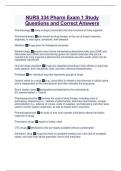NURS 334 Pharm Exam 1 Study
Questions and Correct Answers
Pharmacology ✅study of drugs (chemicals) that alter functions of living organism
Pharmacotherapy ✅also known as drug therapy, is the use of drugs to prevent,
diagnose, or treat signs, symptoms, and diseases
Medicine ✅Drugs given for therapeutic purposes
Biotechnology ✅process may involve manipulating deoxyribonucleic acid (DNA) and
ribonucleic acid (RNA) and recombining genes into hybrid molecules that can be
inserted into living organisms (Escherichia coli bacteria are often used), which can be
repeatedly reproduced
How are drugs classified ✅Drugs are classified according to their effects on particular
body systems, their therapeutic uses, and their chemical characteristics.
Prototype ✅An individual drug that represents groups of drugs
Generic name for a drug ✅(e.g., amoxicillin) is related to the chemical or official name
and is independent of the manufacturer and often indicates the drug group
Brand (trade) name ✅designated and patented by the manufacturer
EX acetaminophen > Tylenol
Pharmacoeconomics ✅involves the costs of drug therapy, including costs of
purchasing, dispensing (i.e., salaries of pharmacists, pharmacy technicians), storage,
administration (i.e., salaries of nurses, costs of supplies), and laboratory and other tests
used to monitor patient responses, as well as losses due to expiration
Pharmacogenomics ✅he study of how one's genetic inheritance affects the body's
response to drugs
Prescription drugs ✅require a written order
OTC drugs ✅Medications that are legally available without a prescription
Schedule I Drug ✅Drugs that have no accepted medical use, have lack of accepted
safety, and have high abuse potentials: heroin and marijuana
, Schedule II Drug ✅Drugs that are used medically and have high abuse potentials:
opioid analgesics (e.g., codeine)
Schedule III Drug ✅Drugs with less potential for abuse than those in Schedules I and
II, but abuse of which may lead to psychological or physical dependence: androgens
and anabolic steroids, some depressants (e.g., ketamine)
Schedule IV Drug ✅Drugs with an accepted medical use in the United States but with
some potential for abuse: benzodiazepines (e.g., diazepam, lorazepam), other sedative-
hypnotics)
Schedule V Drug ✅Products containing moderate amounts of controlled substances.
They may be dispensed by the pharmacist without a physician's prescription but with
some restrictions regarding amount, record keeping, and other safeguards. Included are
cough suppressants
The Food, Drug, and Cosmetic Act of 1938 ✅regulate the manufacture, distribution,
advertising, and labeling of drugs
The Comprehensive Drug Abuse Prevention and Control Act ✅regulates the
manufacture and distribution of narcotics, stimulants, depressants, hallucinogens, and
anabolic steroids and requires the pharmaceutical industry to maintain physical security
and strict record keeping for these drugs and substances
Drug Trial Phase 0 ✅drug testing occurs in animals and small groups of humans
Drug Trial Phase 1 ✅few doses are given to a certain number of healthy volunteers to
determine safe dosages, routes of administration, absorption, metabolism, excretion,
and toxicity
Drug Trial Phase 2 ✅few doses are given to a certain number of subjects with the
disease or symptom for which the drug is being studied, and responses are compared
with those of healthy subjects
Drug Trial Phase 3 ✅drug is given to different populations and different dosages and
by using the drug in combination with other drugs. In double-blind, placebo-controlled
designs, half of the subjects receive the new drug and half receive a placebo, with
neither subjects nor researchers knowing who receives which formulation
Placebo ✅an inactive substance similar in appearance to the actual drug
Drug Trial Phase 4 ✅the FDA allows the drug to be marketed and requires
manufacturers to continue postmarketing monitoring and electronic report submission of
the drug's safety and effectiveness




